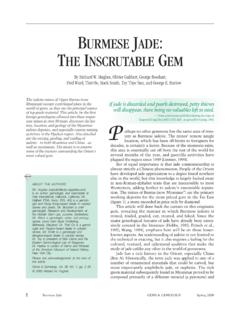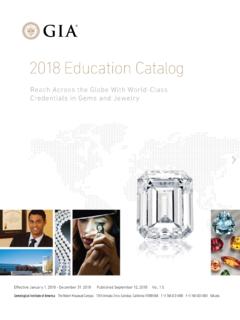Transcription of The Jade Enigma - GIA
1 THE jade Enigma By Jill M. Hobbs jade is one of the most misunderstood gemstones. It is actzlally two separate materials: jadeite and nephrite. Together, these materials have more simulants than most other gems. Thus, it is important to know the various simulants, and to understand how to separate them from jade . This article examines the key identifying properties of green jade (jadeite and nephrite) and contrasts them with the properties of the 10 most common green jnde simulants. Simple visual techniques are emphasized as well as the appropriate gemological tests. - - - ABOUT THE AUTHOR Ms. Hobbs is a gemologist and assistant manager of the Home Study Department, Gemological Institute of America, Santa Monica, CA.
2 Acknowledgments: The author i,r indebted to Chuck Fryer for his invaluable advice and information, and to Peter Keller for his help in the research and direction of this article. Special thanks also go to Susan Kingsbury for the line drawings and to Evelyn Tucker for the design of these drawings. The photographs in figures 4, 5, 6, 8, 9, 10, 11, 12, and 14 were provided by Tino Hammid of GIA Gem Media. Other photo credits appear with the individual figures. "1 982 Gemological Institute of America I t is easy to understand why jade has been considered a "piece of heaven" for centuries. The rich color and soft texture of fine jade have made it a favorite of gem connoisseurs everywhere. It is also easy to understand why many materials have been represented as jade .
3 It is curious, however, that the names for jade are still a sub- ject of controversy and that so much misinformation, myth, and superstition surrounds this gem, especially the treasured green material (see figure 1). This article will try to remove some of the confusion that often accompanies the purchase of jade jewelry or carvings. By introducing the common trade names and misnomers for green jade and its simulants, and by ex- plaining how these materials can be separated from one another, the following text will serve as a guide to the gemology of jade . WHAT IS jade ? Civilizations of all ages have prized this material. In his widely read book on jade , Gump (1962) captures the spell of this gemstone: The Central Asians placed a huge slab of jade before the tomb of Tamerlane to make it inviolate.
4 The pre-Colum- bians made sacrificial knives from it. Aladdin expressed wonder at the fabulous trees of the jade in the under- ground cavern. The Russians carved a whole sarcopha- gus, for Czar Alexander 111, of jade . In both New Zealand and New Calcedonia a jade mere or war club was the chief's symbol of authority. Fathers in the Loyalty Is- lands once bartered their daughters for jade . China built a civilization around the stone. All races and ages that encountered jade valued it. Pre- historic civilization~ recognized jade for its toughness. In China, in the Swiss Lake area in Europe, and in Central America (especially Guatemala and Mexico), prehistoric cultures used jade for functional articles.
5 In the Swiss The jade Enigma GEMS & GEMOLOGY Spring 1982 3 Figure 1. An attractive example of green jadeite used in jewelry (the jadeite measures x x cm). A wide variety of simulants attempt to duplicate the unique beauty and appearance of jadeite. It is enigmatic that although jadeite (and nephrite, which is also known as jade ) have been worked and admired by many civilizations, the true nature of the material is still misunderstood, and its simulants are often misidentified as the original. Brooch courtesy of Mason-Kay, Znc. Lake area in particular, archaeologists have doc- umented that early dwellers used jade for axe heads, scrapers, and instruments of war; they eventually treasured it for aesthetic and symbolic value as well (Foshag, 1957).
6 Curiously, the scientific nature of jade was not fully understood until the 19th century, when Professor A. Damour proved that the gemstone that is commonly called jade is actually two sep- arate and distinct materials: jadeite and nephrite. The former is usually the more valued of the two for jewelry and carvings, because fine-quality jadeite is an intense medium green, whereas even the best nephrite tends to be a darker, more black- ish green. Interestingly, the distinction was made in another culture long before Damour published his scientific findings. When the intense-green jadeite began to enter China from Burma in the middle of the 18th century, the Chinese called it fei-ts'ui instead of yu, which had been the stan- dard name for jade (Hardinge, 1953).
7 In addition, while most early writings purportedly described nephrite, a few of them were said to describe ma- terial that would fall under the modern mineral- ogical classification of jadeite (Foshag, 1957). Although A. G. Werner, in 1788, was the first to apply the mineralogical name nephrite, Dam- our was the first to determine the chemical com- position of this material. In his 1846 publication, Damour established that nephrite is a compact variety of the amphibole minerals tremolite and actinolite. Then, in 1863, Damour reported the very important discovery that jadeite is a separate and distinct species. A member of the pyroxene group of minerals, jadeite is very different from nephrite in both chemistry and internal structure (see box).
8 Thus, it has different properties and a different appearance. These findings revolutionized jade nomencla- ture, and they should have simplified the identi- fication, evaluation, and marketing of jadeite and nephrite. Yet jade remains an Enigma to most buyers. The tradition of myth and misinforma- tion continues today. In addition to the accepted trade names for jade (see table 11, many mislead- ing terms such as "Mexican jade ," "Japanese jade ," "jasper jade ," and "Transvaal jade " are used to market gem materials other than jadeite and nephrite (table 2). With so many materials touted as jade , the buyer must be aware of the names of these simulants as well as their key identifying characteristics.)
9 This article examines both the identification of jadeite or nephrite and the separation of these 4 The jade Enigma GEMS & GEMOLOGY Spring 1982 THE QUESTION OF jade NOMENCLATURE The term jade encompasses two tough, compact, fine-grained materials: jadeite and nephrite. The definition of these two materials is difficult, at best. Strictly speaking, jadeite is a distinct mono- clinic mineral belonging to the pyroxene group and having an ideal chemical composition of NaAl(Si03),. However, ja&ite may be an in- timate intergrowth of jadeite with at least one of two closely related pyroxenes: acrnite [NaFe(Si03)J, or diopside [CaMg(SiO,),]. The three minerals can form a continuous isomorphic sub- stitution series.]
10 The variations in the properties of jadeite are therefore dependent on the propor- tions of each pyroxene present. If enough diopside is present that the mate- rial's chemical composition is intermediate be- tween diopside and jadeite, the material is some- times called diopside-jadeite. The optical and physical properties of this material are normally so close to those of pure jadeite that a distinction is impractical. However, if the material's chern- ical composition is intermediate between acmite and jadeite-or acmite, diopside, and jadeite-its properties and appearance are distinct from pure jadeite and it is commonly known as chloromel- anite. This material is typically blackish green to nearly black; the presence of a significant amount of iron produces a slightly higher refractive index and specific gravity as well.















